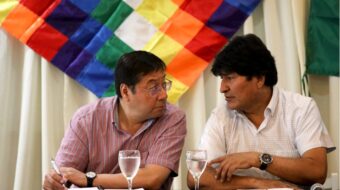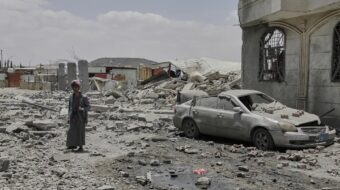Hundreds of people stood waiting outside the gates of Camp Garcia, the U.S. Navy’s firing zone in the island municipality of Vieques. They were waiting until 12:01 AM, May 1, the first full day when the Navy would no longer be in control of Camp Garcia.
At 12:01 they cut the chains holding the gate together. Fences were torn down and hundreds entered, some shouting in jubilation, others with tears in their eyes, all happy. They renamed Camp Garcia, the First of May Free Zone. For the next four days, until May 4, the people of Vieques and Puerto Rico celebrated their victory over the world’s most powerful navy.
Right outside the gates a stage had been set up. Religious, political, civic, and other leaders from Vieques and the rest of Puerto Rico were also there to welcome an end to the military occupation of Vieques. Vieques had been used as a Navy and Marine Corps live ammunition bombing range since the 1940s.
A May Day rally was held in the town plaza in Isabel II with the stage set up in front of the statue of Simón Bolívar. (Vieques is the only place in Puerto Rico that Bolívar and his troops ever landed while fighting to liberate the Spanish colonies in the Americas.)
At the rally, Rubén Berríos, chairman of the Puerto Rican Independence Party, called on Puerto Ricans to reflect on the struggle for peace in Vieques to “extract the necessary lessons so that we can confront the great challenges that lay before our people.” Berríos, who spent 11 months in the firing range as a human shield against the bombing, said that the Navy leaving Vieques is “the most important victory since the American invasion” of Puerto Rico in 1898.
The celebrations, which were organized by a coalition of community organizations fighting to rid this municipality of 9,300 residents of the U.S. military presence, included cultural acts by many Puerto Rican artists. One of these, the popular singer Danny Rivera, said in an interview with a Puerto Rican newspaper that the people who fought for Vieques were “soldiers that believe we can win a better world than that of armed intervention and genocide against other peoples.” Rivera was among the over 1,500 people who served time in federal jail for committing acts of civil disobedience in Vieques.
For the people of Vieques the Navy’s departure is only the first victory, albeit an important one. Organizations like the Committee for the Rescue and Development of Vieques (CPRDV) are demanding that the Navy return the First of May Free Zone to the people of Vieques and Puerto Rico. The CPRDV warned that “the people would return to the use of peaceful civil disobedience to demand its rights if there is any obstacle on the road to peace for our people.” The land had been officially transferred to the Fish and Wildlife Service of the Department of the Interior.
They are also demanding the Navy clean up the toxins and other materials left there as a result of more than half a century of bombings. Vieques suffers from a cancer rate that is 27 percent higher than the rest of Puerto Rico, which is believe to be caused by the carcinogenic materials, including highly toxic depleted uranium (DU) shells, in the former firing range.
According to the Puerto Rican Department of Natural and Environmental Resources, the cleanup of Vieques will probably start within two years and it may take from 30 to 50 years to complete. In 1999 the Navy fired 263 DU shells in violation of federal law. Only 57 of these shells have been recovered to date.
In a mass held on May 2, leaders of the Catholic Church in Puerto Rico declared that the fight for peace in Vieques will not be over until the lands are decontaminated and returned to the people of the island municipality and Puerto Rico.
The Puerto Rican government is applying to have the First of May Free Zone declared a Superfund site for environmental cleanup. They are also asking for funds for the cleanup of Culebra, another military site.
The Navy has already been accused of trying to evade its responsibility when it declared recently that nine of the 17 sites, which had previously been identified as being contaminated, were now classified as requiring “No further action.”
The Navy has a bad reputation regarding its promises on environmental cleanups at sites it has abandoned in a number of places including Hawaii and Panama.
The author can be reached at jacruz@attbi.com









